Student Spotlight: Embedded with Hubbard Street Dance Chicago
Editor’s note: As part of the UMS 21st Century Artist Internships program, four students interned for a minimum of five weeks with a dance, theater, or music ensemble part of our 2015-2016 season. Meri Bobber is one of these students. This summer, she was embedded with Hubbard Street Dance Chicago.
Below, Meri shares her travel stories with the company in advance of their return Ann Arbor on October 27, 2015.
Assume nothing; be curious. This approach to artistry is something I learned from choreographer William Forsythe at Hubbard Street Dance Chicago’s Spotlight Ball on June 1, 2015. The glamorous night was a celebration of dance and highlighted the success and impact of Forsythe’s work, as the main company prepared to perform his choreography in its upcoming season. By the night of the gala, I was already a few weeks into my internship, but I carried this advice with me as I continued my summer in Chicago as a UMS 21st Century Artist Intern.
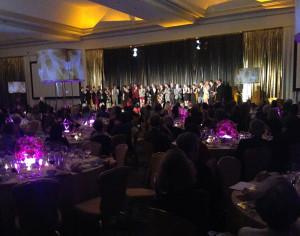

On left, the gala was held in a ballroom of the Fairmont Hotel in downtown Chicago. In this shot, dinner guests applaud as Artistic Director Glenn Edgerton introduces all the professional dancers of Hubbard Street. On right, Hubbard Street’s second company, comprised of early-career artists, perform a movement composition exercise to supplement the dance education of Chicago elementary school students.
My internship at Hubbard Street was structured so that I would rotate departments weekly for two months. This structure ultimately proved to be incredibly appropriate, as I saw firsthand that non-profit organizations require their employees to wear many hats, big and small, simultaneously, and to still maintain the ambition to learn on the fly, to jump in wherever he or she is needed. For example, the accounting manager at Hubbard Street also serves as IT. A former professional dancer of the company is now its Manager of Communication on the marketing team. When I joined the second company for a day of several dance outreach performances at Chicago area schools, the artistic director drove our van.
I practiced the same adaptability in my internship, beginning in artistic administration, where I was trusted with an important, ongoing project right away. One of the repetiteurs from The Forsythe Company was to come to Chicago and set three of William Forysthe’s works on the dancers for the performance Hubbard Street will bring to Ann Arbor in October. As an artist of German citizenship, he needed a visa for his work in Chicago. So, although I bounced around departments, I worked throughout my internship to research this repetiteur’s career, assemble resources, and write a coherent paper about him that proved the legitimacy of his trip and his work at Hubbard Street. I needed to present enough evidence to prove that he was the best and only man for the job. My supervisor worked closely with me on the project, taught me how to address the guidelines required by the government, and left me confident with a new, important skill. One of my highlights from the summer was the day that my supervisor informed me that the application had been accepted by the government. I met him in person later on, and his gratitude for my help with his application touched me. The work I had put into it proved successful for Hubbard Street and the Forsythe production.
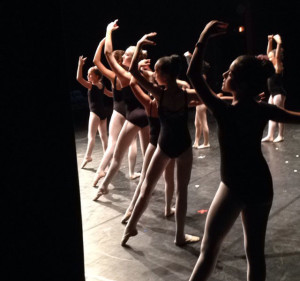
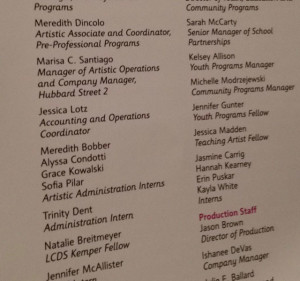
On left, a shot from backstage of the Hubbard Street Youth Showcase where I helped the professional dancers of tomorrow make it on stage in time for their numbers. On right, I spent the week leading up to Hubbard Street’s Summer Series at the Harris Theater helping out at dress rehearsals backstage. It was a treat to find my name included on the Hubbard Street Staff listing in the program on opening night!
I switched responsibilities each Monday. I served in the marketing department, where I initially felt far out of my comfort zone but ultimately learned a lot in just five days; the youth education department, where I made great friends with other interns and helped the youth showcase recital run smoothly; backstage of the Harris Theater downtown, where I assisted Hubbard Street’s main company manager during a production that featured the work of resident choreographer Alejandro Cerrudo; and the development department, where I learned about external affairs and donor profiling, and helped out behind the scenes at the aforementioned gala. And that’s just to list a few!
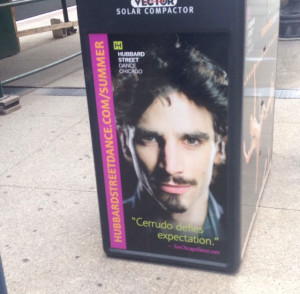

On left, Hubbard Street marketed the Summer Series show with ads like this all over street kiosks downtown. It was fun to learn about such marketing strategies at work, then go see them in action on my walks to and from the theater. On right, Hubbard Street’s Resident Choreographer Alejandro Cerrudo signed my program on closing night of the Summer Series.
Following the internship, I stayed on for a third month to participate in the college-level summer dance intensive. This is a program I enjoyed thoroughly last summer as well. I was happy to have Hubbard Street’s artistic staff, alumni, and current dancers give me another satisfying amount of choreography to study and a technical kick-in-the-pants. The training tested my adaptability as a dance artist, connected me with talented young dancers from around the country, and filled gaps in my technique. It was a special experience to come to the building every day and spend 8 hours in the studios just as Hubbard Street’s professional dancers do. I studied ballet, yoga, Pilates, improvisation, Gaga technique, Horton technique, partnering, and a variety of diverse repertory excerpts that required me to dance with different qualities and intentions. I sweat. A lot.
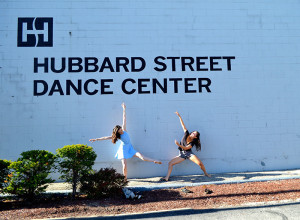

On left, one of my closest friends from school, Lena Oren, came into Chicago for the summer intensive. Here we are dancing outside of Hubbard Street’s building, located on Jackson Boulevard and Racine Avenue. On right, the summer intensive concluded with an in-studio showcase, which offered my fellow dancers and me the opportunity to perform the repertory excerpts we had been studying for the past four weeks.
Beyond working and dancing at Hubbard Street’s building in the West Loop, I found that living in Chicago in the summertime was delightful. I grew up in Milwaukee, but hanging out on Lake Michigan’s lakefront never gets old. The Brown Line to Kimball route of the Chicago Transit System (the “L,” as locals call it) offers stunning views of the downtown Loop. The Taste of Chicago food festival, the Bean, Buckingham Fountain, and the city’s diverse and characteristic neighborhoods gave me much to do and explore. I had the priceless company of my older sister, who has lived in Chicago for more than a year now, and my best friend from school, who traveled from California to participate in the summer intensive at Hubbard Street with me. We ate out, walked the lakefront, hung around Clark Street, and attended street festivals, parades, and shows. I also used my weekends to attend dance classes and shows anywhere and everywhere in an attempt to acquaint myself with Chicago’s greater dance community.
I subleased two apartments during my three months there: one from a coworker at Hubbard Street, a 15-minute walk from the West Loop (where Hubbard Street’s building is located) in the quaint, historic Little Italy neighborhood of Chicago. The other sublet was more of a gamble. I lived with a stranger far uptown at Lawrence and Clark, a location that required me to learn how to navigate Chicago’s public transportation system each morning in order to get to work. In terms of my mysterious roommate, I actually got very lucky. I lived with a Chicago and dance enthusiast who showed me around the city, specifically the characteristic area of Lincoln Square, and has become one of my closest friends.
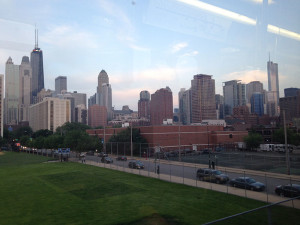
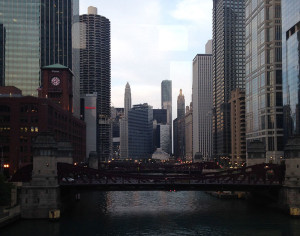
On left, Chicago skyline from the Brown Line train north to Kimball. On right, downtown loop of Chicago from the Brown Line train north to Kimball.
And so, both inside and outside of Hubbard Street’s building, my summer in Chicago fulfilled and excited me day-by-day. The pressure of having new assignments and needing to catch on to the operations of a new department at Hubbard Street every week honestly made me a little anxious on Monday mornings (especially during my week in marketing, an area in which I had no previous experience). The variety of choreography I studied during the intensive also required me to be flexible, in more ways than one! So I learned to adapt to the diversity in both the office and the studio, and to do my best with all that was thrown my way.
My to-do list throughout those three months was anything but monotonous. Every morning when I arrived at the building, I knew I could be asked to do just about anything to help make dance happen. I rolled out a marley floor. I organized video archives. I sifted through the dusty costume cage in the back warehouse. I wrote and I researched. I faxed and I answered phones. I brainstormed and I went to meetings. I ordered and picked up gifts for the choreographer on opening night. I ran the video camera at technical and dress rehearsals. I went to dance class and came back day after day with more sore spots and bruises. I cared to finesse the individual details and qualities of each piece I was taught. I tried assuming nothing and being curious all summer long, and it was an impactful approach to my working to bridge my student experience with becoming a professional.
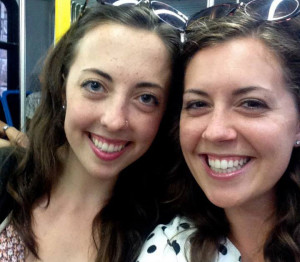
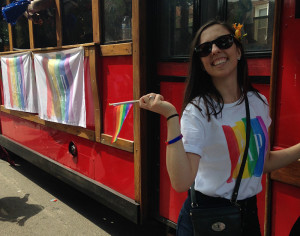
On left, my Chicago-based older sister and I on a city bus. On right, Here I am at the Chicago Pride Fest, one of the many summer city activities I soaked up. Others included Taste of Chicago, the Blackhawks Stanley Cup Victory Parade, and free concerts at the outdoor Jay Pritzker Pavilion.
I left Chicago with a big-picture understanding of the many factors that make up the dance powerhouse that is Hubbard Street Dance Chicago. The organization offers more than 70 classes a week to the public, rents studio space out to dance projects and companies, holds special dance education workshops through The Parkinson’s Project and The Autism Project, educates young dancers in a variety of dance styles, practices dance outreach in Chicago’s public schools, develops early career artists through the second company, and produces professional shows that feature a wide range of choreography on national and international stages.
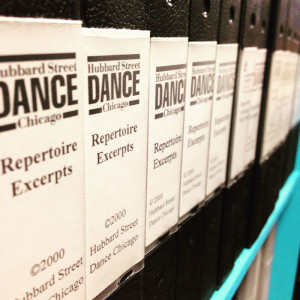
I spent one afternoon getting lost in Hubbard Street’s media room, which contains rehearsal and performance footage that dates back to the 1980s.
I now have a personal understanding of the effort, talent, teamwork, and dedication it takes to maintain such an umbrella for dance. The company dancers themselves are no less exceptional. They are thoughtful, articulate, versatile movers who appear almost invincible in the studio and in performance. When they grace the stage of the Power Center this October, you’ll see what I mean.
Hubbard Street Dance Chicago returns to Power Center with an evening of works by choreographer William Forsythe on October 27, 2015.
Interested in more? UMS Artist Services Manager Anne Grove was once company manager of Hubbard Street Dance Chicago. Read our interview with Anne.
Student Spotlight: Embedded with New York Philharmonic
Editor’s note: As part of the UMS 21st Century Artist Internships program, four students interned for a minimum of five weeks with a dance, theater, or music ensemble part of our 2015-2016 season. Evan Saddler is one of these students. This summer, he was embedded with the New York Philharmonic.
Below, Evan shares his travel stories with the orchestra in advance of their return Ann Arbor for three concerts October 9-11, 2015 and many surrounding residency activities.
It was April 1, 2015 and I hadn’t heard back from UMS about the 21st Century Artist Internship. Despite the feeling that I had done well in the intense interview process (in front of a panel of eight core UMS staff members), I assumed that no communication meant that I hadn’t made the cut; thus I began to make other summer plans. Later that same evening however, a voicemail appeared in my inbox. It was one week old. The contents of this stale voicemail: Jim Leija, Director of Education and Community Engagement at UMS, was informing me that I would be moving to New York in less than a month’s time to intern with the New York Philharmonic. I contacted Jim right away, apologized for my tardiness, and accepted the offer diligently.

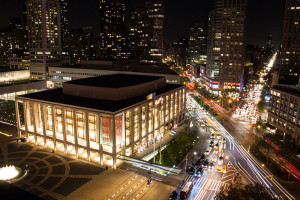
Photos: On left, lower Manhattan taken from the Manhattan Bridge. On right, a view from a rooftop looking down at Avery Fisher Hall at Lincoln Center, home of the New York Philharmonic.
My world went into chaos mode. The end-of-year to-do list was perpetual. I was finishing up classes and projects in Ann Arbor, preparing for exams, and performing my Junior Recital. And now I also had to find a place to live for six weeks in Manhattan, book the flights, and prepare for an experience of a lifetime. Also, I didn’t know exactly what I was getting into. I had a phone interview with my boss to-be, Vice-President of Artist Planning at the New York Philharmonic Ed Yim, followed by follow-up interviews with two members of his team. Thankfully, both phone interviews went smoothly, and I got the green light. I would have many more interviews to come, I discovered, and these interviews would become a crucial component of my internship.
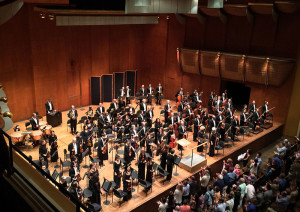
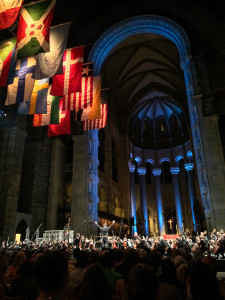
Photos: On left, after a performance of Brahm’s Symphony No. 4 with Manfred Honeck. On right, following a Memorial Day concert open to the public at St. John The Divine Cathedral on the Upper West Side.
The school year drew to a close, and I found myself transplanted to New York City. I was fortunate to be put in contact with the fabulous Lauren Flanigan, an operatic-soprano who has sung with the New York City Opera and the Metropolitan Opera. She runs a wonderful organization called the Music and Mentoring House. Lauren has created an incredibly supportive environment that caters to young artists studying, auditioning, and transitioning to living in New York City. She graciously took me in and allowed me to stay in her gorgeous Harlem walk-up brownstone townhouse for six weeks. She even cooked breakfast and dinner Monday through Friday for all of us living in the house. In addition, every Sunday evening before the work week began, all of us students living in the house, and some of Lauren’s close friends, colleagues, and neighbors gathered for what I called “family dinner”; a grill-out on the back patio (yes, in New York City) enjoying food and wine, discussing music, art, life, and one another’s company. It was always a highlight of my week. In addition to all of that, Lauren also set up a lesson for me with drummer Barry Altschul, one of Chick Corea’s early drummers. The entire situation could not have been better.
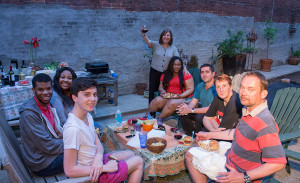
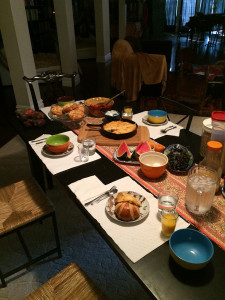
Photos: On left, family dinner, a weekly Sunday-evening tradition at Music and Mentoring House, which included grilling out and celebrating summer with new friends! On right, the goodness I woke up to before leaving for Lincoln Center; one could say we had it made at Music and Mentoring House.
I cherish the time that I had during my internship with the New York Philharmonic. I learned a great deal about the inner-workings of a world-class performing-arts organization, experience that will be invaluable to me moving forward. The extent of planning, precision of logistical execution, leadership, and effort on the part of everyone, on a daily basis at Avery Fisher Hall, is astounding. Most of this work is unseen by the average concertgoer. In addition to day-to-day administrative duties, I conducted formal and informal interviews with countless people within the New York Phil. The interviews helped me to see how component parts makes up the whole. Whether I was meeting with someone from the marketing department, the production team, the archivists, a musician in the orchestra, or the president of the organization, everyone was passionate about making a positive contribution to the forward momentum of the organization to ensure it’s longevity in the ever-changing 21st century’s musical and artistic climate.
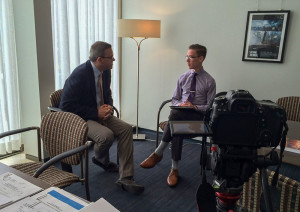
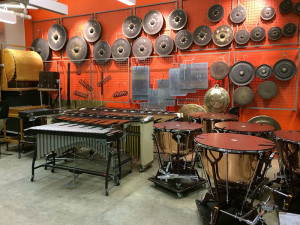
Photos: On left, taken during my video interview with President of the New York Philharmonic, Mr. Matthew VanBesien; the culmination of my series of interviews with people throughout the organization. On right, Associate Principal Percussionist Daniel Druckman took me on a brief tour of the Philharmonic’s extensive percussion collection.
Each week, I was able to attend rehearsals and the orchestra’s concerts for free, a tremendous gift of this internship. I observed and was a part of weekly production meetings, which outlined logistical aspects of upcoming performances at Avery Fisher Hall and around the city, and was also put to work in the Artistic Planning department on many communication and planning agenda items for the orchestra’s upcoming residency in Shanghai, China. Scheduling those conference calls between Shanghai and Manhattan (a 12-hour time difference) was no easy feat! Neither was learning how to use the office telephones; during my first week I accidentally hung-up on a board member (among many others!) while trying to transfer calls. You could say there was a bit of a learning curve to my office know-how.
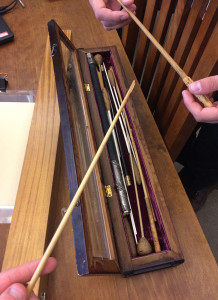
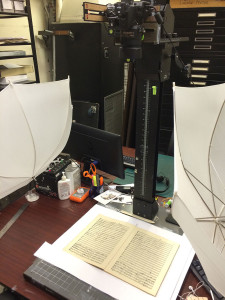
Photos: On left, during a visit to the Archives, I was shown a collection of batons owned by none other than Leonard Bernstein. On right, an interesting process through which the archival team uploads scores to the public online database. This is done through photo (with camera mounted vertically) rather than through scanning or copying.
Not only was I able to work at the New York Philharmonic at Lincoln Center for six weeks, I also lived in one of the greatest cities in the world. Practicing photography, attending concerts outside of the Philharmonic, going to museums like the MET and MoMA, and exploring chic restaurants in the Village occupied my nights and weekends.
I cannot thank the good people at UMS and the New York Philharmonic enough for this wonderful opportunity. The experience will stay with me for a lifetime, and I cannot wait to share its stories with others.
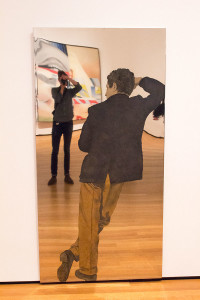
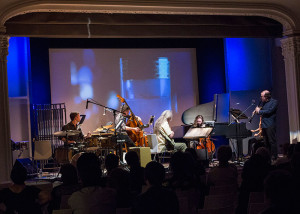
Photos: On left, taken on one of my off days exploring the Museum of Modern Art. On right, one of the great privileges of living in New York City during the early months of summer was the vast number of concerts going on at any one given moment; this was at a performance by Bang on a Can.
The New York Philharmonic returns to Ann Arbor October 9-11, 2015.
Interested in more? Explore New York Philharmonic in our archives.
Student Spotlight: Artist Internships for the 21st Century
The fast changing environment of the 21st century poses new demands on artists. They must reach potential audiences in innovative and unexpected ways. To address these needs, the U-M School of Music, Theatre & Dance and University Musical Society (SMTD and UMS) launched a new student arts internship program for four SMTD undergraduate students in the summer of 2014. Chosen through a competitive application process, each student fellow interned for a minimum of five weeks between May and August 2014 with a professional dance, theater, or music ensemble that UMS planned presented during the 14-15 season. The program will continue and we’re currently selecting fellows for next season.
Explore the journeys of our 14-15 student fellows!
Héctor Flores Komatsu
 Héctor Flores Komatsu spent five weeks with Théâtre de la Ville in Paris, France. Read his travel stories while embedded with the company and his interview with company members.
Héctor Flores Komatsu spent five weeks with Théâtre de la Ville in Paris, France. Read his travel stories while embedded with the company and his interview with company members.
Libby Seidner
 Libby Seidner was embedded with the San Francisco Symphony. Read her travel blog. Libby conducted video interviews with the orchestra, too:
Libby Seidner was embedded with the San Francisco Symphony. Read her travel blog. Libby conducted video interviews with the orchestra, too:
Sophia Deery
Sophia Deery was with Kyle Abraham’s Abraham.In.Motion company. Explore behind the scenes moments from the summer with the company, or photos from company’s residency in Ann Arbor. What she loves about the company’s work:
Hillary Kooistra
 Hillary worked with the Trisha Brown Dance Company. Read her interviews with company members. We also worked with Hillary to create in-depth coverage of our free UMS Night School evening “course” focusing on dance.
Hillary worked with the Trisha Brown Dance Company. Read her interviews with company members. We also worked with Hillary to create in-depth coverage of our free UMS Night School evening “course” focusing on dance.
Interested in more? We can’t wait to introduce our next round of student fellows to you! Keep up with the program here on our blog.
Got questions or suggestions? Share them in the comments below.
Student Spotlight: On the Road with Trisha Brown
Editor’s note: During the summer of 2014, UMS launched a new 21st Century Artist Internship program. Four students interned for a minimum of five weeks with a dance, theater, or music ensemble part of our 2014-2015 season. Hillary Kooistra is one of these students. She spent the summer in New York and on the road with the Trisha Brown Dance Company.
Below she recounts her travels with the company. The Trisha Brown Dance Company will perform Proscenium Works, 1979-2011 at the Power Center on February 21-22.

TBDC Dancers Tara Lorenzen, Nick Strafaccia, and Olsi Gjeci perform “I’m going to toss my arms — if you catch them they’re yours” on Pier 15 at the South Street Seaport in NYC.
As an embedded intern with the Trisha Brown Dance Company (TBDC), I worked alongside TBDC administrators and artistic directors, observed the company in rehearsals, befriended the dancers, learned repertory and improvisation/ composition techniques from TBDC alumni, and watched many, many performances. During my internship, I accompanied the dancers and TBDC artistic staff on two trips. This gave me a taste of life on the road for a dancer in an international touring company and allowed me to develop a deep understanding of the diverse performance programs that the Trisha Brown Dance Company presents.
The first stop on my personal tour with TBDC was Annandale-on-Hudson, New York, where the company was invited to perform selections from its Proscenium Works, 1979-2011 tour (the final tour of Trisha’s repertory works specifically choreographed for the stage, coming to Ann Arbor in February). After a NYC performance of “I’m going to toss my arms, if you catch them they’re yours” (fondly referred to by the company as “Toss”), I joined the company in a 15-passenger van headed toward Bard College. Though I was new to the touring artist lifestyle, I quickly learned that this pace is typical for the dancers. In one day, they danced on a pier overlooking the East River, drove upstate from New York City, and prepared for the next round of performances!

Load-in of Robert Rauschenberg’s set piece for “Set and Reset” prior to the company’s Bard SummerScape performance.
We arrived at Bard late that night. Throughout the weekend, I found myself enchanted by little details of tour life, as mundane as they may seem. I loved the trips to the grocery store to stock up on weekend meal essentials, the hospitality provided by the presenter, and the pre-rehearsal or performance rituals of each individual dancer before they all came together as a group; these helped me recognize touring as a realistic and obtainable aspect of a professional dance career, as opposed to something far-fetched and imaginative.
Even more exciting for me was the opportunity to watch the program in technical rehearsal and performances. The company presented “I’m going to toss my arms — if you catch them they’re yours,” “Set and Reset,” and “If You Couldn’t See Me.” They will bring the latter two to Ann Arbor. Seeing Diane Madden, co-associate artistic director of the company, lead the dancers in onstage rehearsals was like getting a sneak peek at the man behind the curtain before the grand unveiling.

TBDC Summer Intensive students with Company alumnus Keith Thompson.
My impression of the works was further enhanced when I watched them in performance with full costumes, lights, and set. Trisha valued the visual design elements of dances as much as she did the movement — collaborating frequently with artists such as Robert Rauschenberg and Donald Judd — and her choreography breathed a new light with the integration of additional production elements. I saw the program three times, and each time I noticed something new, but also recognized familiar moments or images. I’ve grown to admire this about Trisha’s work: her dances have multiple layers, but follow a cohesive line that runs parallel to the surprising twists and turns.

Dancing a part of “Newark” at the TBDC Summer Intensive.
After our weekend at Bard, I parted ways with the company. I returned to New York to serve as the on-site coordinator for the TBDC Summer Intensive, a three-week workshop that offered up to six hours of technique, repertory, and composition classes each day. I acted as a point of reference for students and teachers and was also able to dance! Classes allowed me to further explore the works I had grown to know intimately as an audience member, and to embody the movement that I only saw and read about up until this point. Composition/improvisation class revealed the techniques behind choreographic concepts I had observed in Trisha’s work and allowed me to apply them to my own dance making. Some of what I learned will surely find its way into the work I create for my Senior BFA Concert this coming April!
In August, I reunited with the company for my second tour experience of the summer, a performance of Trisha’s Early Works at the Lynden Sculpture Garden in Milwaukee, WI. Before she began choreographing larger works such as “Set and Reset” for the proscenium stage, Trisha concentrated on shorter, site-adaptive dances for alternative venues such as museums, rooftops, and parks. The company performs these works for events throughout NYC and international tour venues and will continue to concentrate on these types of performances after the conclusion of Proscenium Works, 1979-2011.

TBDC dancer Tamara Riewe leads young members of Lynden’s summer camp in demonstrating poses inspired by the sculptures in the garden.
This trip to Milwaukee marked my first foray into site work, and I quickly learned how much extra effort must go into presenting dance in any area other than a stage. We spent the first day at the Garden traveling from spot to spot, considering which dances would work best in front of which sculptures, identifying the strongest vantage points, and mapping a path for the audience to travel between locations. Since all the company members were not present for the initial site visit, I often assumed the role of a stand-in to help the team visualize dances in different locations. I was able to try some of Trisha’s choreography and tasks on site, doing her signature “Group Primary Accumulation” while floating on a raft in the middle of a pond and walking down the side of a tree for “Spiral.”
Trisha’s Early Works are full of these fun tasks and were an absolute blast to watch in performance. In one work titled “Sticks,“ dancers moved through a series of postures while balancing long, wooden sticks on their heads. This lighthearted performance atmosphere contributed to the informal relationship established between the dancers and audience. Throughout the performance, the dancers interacted with us, acknowledging when something wasn’t working and inviting us to join in on their fun. This, I discovered, was a delightful difference between the Early Works and Proscenium Works programs, the latter of which demonstrates a traditional separation between performers and audience.

TBDC members perform Sticks at the Lynden Sculpture Garden in Milwaukee, Wisconsin.
Seeing the Early Works really sparked my interest in dance for alternative spaces, which I’ve been exploring since I’ve returned to Michigan. This marks one of the many ways that my travels with the company influenced my impressions of Trisha’s work and view of the dance field. I grew leaps and bounds throughout the summer, but my experience would not have been complete without the opportunity to climb in a van with 11 professional dancers or to walk down the side of a tree in front of the company’s associate artistic director. I began my rich and unique experience as an intern “embedded” with the company, but emerged as a knowledgeable, conversant member of the TBDC family.

Smiling with Carolyn Lucas, Diane Madden, and the TBDC company members. Thank you for a wonderful summer!
Artist Interview: Traveling with Théâtre de la Ville
Editor’s note: This summer, UMS launched a new 21st Century Artist Internships program. Four students interned for a minimum of five weeks with a dance, theater, or music ensemble part of our 2014-2015 season. Héctor Flores Komatsu is one of these students. He spent five weeks with Théâtre de la Ville in Paris, France.

Théâtre de la Ville performs Six Characters in Search of An Author at the Power Center in Ann Arbor on October 24-25, 2014. Photo by JL Fernandez.
Scene
13:30, May 23, 2014, Paris, France. En route to final dress rehearsals of Six Characters in Search of an Author at Le Forum Blanc Mesnil, a banlieu (suburb) located at the northern outskirts of the city proper. Cast and production members sit throughout the van shuttle between Théâtre de la Ville and our current rehearsal space.
Les mecs (the dudes) hang out in the back, and one of their phones alternates between the American and French pop hits of the moment. Some nap, some read, some eat their lunch. They converse in the relaxed, soft, yet gutturally vibrant and “chic” French that had initially been both inviting and intimidating to my Mexican-American mélange of an accent.
Actress Sarah Karbasnikoff’s sweet, edgy, yet motherly voice, proper for her character, rises in joyous laughter, while actress Valerie Dashwood’s dark, yet subdued, cedar timbre seduces the air with chuckles, not unlike those heard from her character, the Step-Daughter. The laughter is inviting, I sit across them, speaking in “tu,” not “vous,” as they had requested.
We chat for the readers in Ann Arbor, of which Sarah has fond memories with Rhinos stampeding through the fallen autumn foliage. (Théâtre de la Ville last visited Ann Arbor to perform Ionesco’s Rhinocéros in 2012.)
Héctor Flores Komatsu: You are a very interesting mother-daughter stage pair! Could you talk a bit about your characters’ relationship in the show?
Sarah Karbasnikoff: Well, I play the Mother, who… Let’s just say she suddenly arrives at the theater with her first husband and all of her children.
HFK: Hmm…
Sarah: Ha! That’s what you need to know, I don’t think I should say more!
[Laughter]
Valerie Dashwood: As for me, I play the “Step-Daughter.” She is such because her mother…
Sarah: That’s me…
Valerie: Was initially married to the character of the Father, with whom she had…
Sarah: A boy.
Valerie: Yes, a boy… Just one boy.
Sarah: Voila!
Valerie: Afterwards, she “had” a second man, my true father, with whom she had three children of which I play the eldest, the Daughter.
HFK: What would you then say is the fundamental need, desire, of the mother, of the Step-Daughter, of the family as a whole? What is it? Is it love? Is it to unite the entire family? Is there a common desire as a family?
Sarah: Well, that will certainly differ for each character.
Valerie: For the Step-Daughter there’s no need or desire to be part the family. One of the first things she says is that she “will take off – fly away!” because she doesn’t want to be part of it.
Deep inside, she detests her Step-father, and she also hates his first, legitimate, son. She speaks a lot about legitimacy, because perhaps she doesn’t feel entirely legitimate. She doesn’t have legitimacy even within society, given that she’s had to prostitute herself to support her mother and siblings. That’s her point of view.
Her desire is, more than anything, is to self-destruct, through which she can emancipate herself from her family, become and adult.
HFK: She fights for her freedom!
Valerie: She fights for her freedom!
HFK: For the mother it seems to be quite the opposite.
Sarah: Each day I discover her a little more. At this moment I have the impression that, yes, she seeks to see her son again, that is certain, because she wasn’t there for him, and so there’s some degree of guilt. Her two youngest children die, and eldest daughter wishes to escape from her. So yes, her greatest desire is to bring everyone together but, alas, that’s impossible. Her life is her children, all of whom escape from her, leave her.

During rehearsal with Théâtre de la Ville. Photo by Héctor Flores Komatsu.
HFK: How has the process been for you, as a new actress in this restaging, stepping into a role originated by someone else?
Sarah: Well, first one must do what’s already been done and understand what already exists. I’ve been stepping into the shoes of the original actress.
And now, with each run, I begin to understand the reason behind her movements, the psychological motivations. At first they were mere just movements, crossing from one place to another, and I simply memorized them; it was very concrete, very technical work. And then, from that point, I began to create the character.
HFK: For you Valerie, having played this role in the original production twelve years ago, what has it been like this time? What has been unearthed once more? What has been newly discovered?
Valerie: What’s been really interesting for me, since it’s been twelve years since I played this role in the original production, is that upon returning to this play, I could not perfectly recall many specifics, but I still had a global feeling of the character, the violence, the pain, and of the will – that’s what it is! The will of the character, is what I remembered well.
However, I could barely remember the text – except for the song! Bizarrely, that had completely stayed with me; I remembered the song… but not my lines!
But then when we read out the play all together at Théâtre de la Ville, with Hugues [Quester, who plays the Father] and Alain [Libolt, who plays the Director], hearing their voices and feeling their energies through the text, the memory came back to me. By reading with them, I was surprised to feel the same emotions from years ago resurface, as if something which long laid dormant suddenly awoke, opening itself. Voila!
After that, relearning the text was very easy.
HFK: What is different today, than how it was twelve years ago?
Valerie: The biggest difference is that twelve years ago I didn’t have children, and now I’ve had two. So my maternal instinct, the one my character has for her little sister, feels very different. Motherhood has hit me hard, and it affects how I act, even in the way I look at the little girl. Sans resorting to any psychological tricks, I instinctively see my daughter in the little girl. I have a child now… And that fact greatly affects how I act, knowing that this little girl, in the play, will die.
I don’t think I could ever do this in the same way as I did twelve years go.
Also, having worked so much in just the past ten years, I feel much more physically available in my own body, much more reserved. At the time, the nudity had originally been somewhat difficult for me, but much less so nowadays. That scene, which I came to fear, I now approach with serenity, even when it’s hard to play.
HFK: And now for my last question for you. I’ve noticed that there’s a lot of love and care behind the scenes among the cast. And for you two, who play Mother and Daughter on stage but are much closer in friendship and in age off-stage, how does that affect your stage relationship?
Valerie: All I can say is… Just like in our previous play, I played the mother to Sandra [another Théâtre de la Ville actress who also plays one of the “actresses” in Six Characters]. I never feel the need to ask myself whether this is or isn’t “coherent,” even if we are only twelve years apart. In theatre, we have what we call, at least in French, a “convention” to suspend disbelief. So right now, Sarah may be playing my mother, and we understand each other really well, which is good because playing this relationship requires great emotional investment. We can support that off-stage. Our closeness strengthens the bond vital to plunging into the work together.
Sarah: For me it’s very similar. During the show I don’t think at all about the age difference. To feel Valerie as she plays her character, I do nothing more than to say “she’s my daughter.” That’s it, I don’t see the age at all. There’s also an understanding of our respective pains, because we know each other personally. That really gets me, it truly does. She does, her pain. She might not truly be her character, but we form an affinity, a bond.
We streamline into casual conversation, and soon enough arrive at the theater. An hour into the rehearsal, as everybody gets into costume and warms into their roles Valerie receives a phone call. Her youngest child isn’t feeling well. She ponders the symptoms, trying to figure the right remedy. There’s the natural concern of the working actress-mother in the midst of rehearsals. She seeks her stage-mother Sarah, a veteran mother in various senses, for reassurance. That’ll do it,” Sarah says. For a moment, the parallel lines of reality and fiction intersect, not unlike in the play, as the two women connect through maternity.
Interested in more? Look for Flores’s behind-the-scenes photo-essay covering his time with the company.




